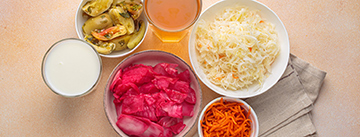
Apple Acidification for Home Canning
The Ball® Blue Book, 38th edition, recommends the acidification of apples in canning recipes to ensure a wider margin of safety against potential botulism-causing bacteria. Why did Ball® make this recommendation?
A study conducted by the Ball® Home Canning Test Kitchen showed that some modern apple varieties along with growing conditions and techniques can produce apples that are less acidic than originally thought. Historically, apples were considered safe for water bath canning without added acid since they were below the safe pH of 4.6. Apples with a pH above 4.6 potentially can create a more hospitable environment for harmful bacteria, like Clostridium botulinum. Further, apples, like many fruits, generally decrease in acidity during storage. Adding lemon juice to canning recipes ensures that the pH of the canned product remains below 4.6, which is the critical threshold for inhibiting the growth of C. botulinum. Per a Ball® statement, “the quantity of lemon juice added to each (recipe) was based on experiment of different types of apple recipes using the highest pH apple species that was identified, and pH modeling to understand the margin of different pH and temperature thresholds while keeping existing processing time recommendations the same.”
Out of an abundance of caution, Ball® has added bottled lemon juice to all apple-based recipes where the apple was expected to be the lowest pH ingredient in the recipe and incorporated that guidance into all Ball® home canning 2024 recipe publications. Ball® does not currently recommend that consumers discard any apple products they have canned previously as prior publications are still within USDA recommendations. Rather the company is advising consumers using Ball® recipes in publications beginning 2024 to follow the acidification guidelines.
The best practice for home canners is to always use the most current version of a recipe publication and to follow tested recipes as researched and written by reputable recipe sources like the USDA, NCHFP, cooperative extension services, and Ball®. All researched recipes will include updated guidelines for that recipe at the time of publication.
Ball® acknowledges that the National Center for Home Food Preservation (NCHFP) and USDA have not updated their guidance on apple acidification and that the company is unaware of any documented safety issues arising from current apple recipes.
View the source article: Why was lemon juice added to apple recipes in the Ball Blue Book 38th edition?
Wild and Alive: The Fermentation Movement Returns
 Fermentation is one of the oldest methods of food preservation. It has been practiced worldwide for thousands of years – long before we understood the science of fermentation. Today, fermentation not only preserves food, but is praised for its cultural roots, nutritional benefits, and bold flavors. Consumers are using fermentation to make yogurt, sourdough, kimchi, kombucha, and more!
Fermentation is one of the oldest methods of food preservation. It has been practiced worldwide for thousands of years – long before we understood the science of fermentation. Today, fermentation not only preserves food, but is praised for its cultural roots, nutritional benefits, and bold flavors. Consumers are using fermentation to make yogurt, sourdough, kimchi, kombucha, and more!
What is fermentation?
Fermentation is when “good” microorganisms (bacteria, yeasts, mold) breakdown sugars or carbohydrates in foods or beverages without oxygen. This creates acids, alcohol, and gases that help to preserve and create big flavors and diverse textures in fermented foods and drinks.
Types of Fermentation
There are three main types of fermentation: alcohol (beer, wine, spirits), acetic acid (vinegar, kombucha), and lactic acid (yogurt, kimchi, sauerkraut). Sourdough uses a combination of alcohol and lactic acid fermentation. The yeast from alcohol fermentation helps the bread rise while lactic acid contributes unique, tangy flavors.
How long is the fermentation process?
Vegetables can be as short as 1-2 days versus alcohol that can take several weeks. Factors such as temperature, type of yeast or bacteria, sugar content, and desired flavor can all affect fermentation times.
Health Benefits of Fermentation
Many people enjoy fermented foods for their use of raw ingredients and little to no added preservatives. However, much of the popularity in fermentation stems from the health benefits.
- Improved Digestion: Fermentation partially breaks down sugars, starches, and proteins, for easy digestion. For example, the lactic acid in yogurt and kefir break down lactose. People with lactose intolerance may better tolerate these foods.
- Probiotics: Fermented foods can contain “live” bacteria or probiotics that may help improve gut health, immune function, and balance the gut microbiome.
- Nutrients: Fermented foods can be rich in vitamins! In fact, they can have increased levels of vitamins like A and C. Fermentation can break down compounds that block mineral absorption, helping your body absorb more iron, calcium, and zinc.
Benefits of fermented food can vary based on the type of food, if it contains live cultures, and your individual health goals. Look for “Live Active Cultures” on the food label as not all store-bought fermented foods will contain live probiotics.
Fermentation at Home
To ferment food at home, start with some basic tools, patience, and a good understanding of food safety. Below are some tips to get you started:
- Wash and sanitize your containers, equipment, and food contact surfaces.
- Use canning or pickling salt for best results.
- Filtered or spring water is preferred over tap or well water. Do not use distilled water.
- Keep food submerged in the brine to reduce the risk of mold.
- Cover container with an air-tight lid.
- If you see mold, sliminess, or an off odor, discard the food. When in doubt, throw it out!
For questions or tested recipes, contact your local Extension office, or visit the website of the National Center for Home Food Preservation.